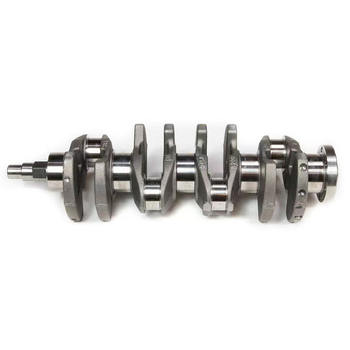A Brief History of Crankshaft Manufacturing
To truly appreciate the evolution of crankshaft manufacturing, let's take a quick trip down memory lane. In the early days, blacksmiths would manually forge crankshafts using hammers and anvils. As technology progressed, the forging process became more automated, with machines taking over the heavy lifting. Fast forward to today, and Computer Numerical Control (CNC) machines have revolutionized crankshaft production, offering unparalleled precision and consistency.
The Forging Process: Strength Through Simplicity
Forging is a tried-and-true method for creating crankshafts. It involves heating a metal bar and then shaping it under extreme pressure. This process imparts unique properties to the material, including increased strength and toughness. For decades, forged crankshafts were the go-to choice for high-performance engines due to their durability and reliability.
Enter CNC Machining: Precision Takes Center Stage
While forged crankshafts certainly have their merits, they're not without limitations. Traditional forging methods can result in slight variations from one part to another, which may not be acceptable in certain applications. Enter CNC machining.
The Advantages of CNC Precision
CNC machines offer numerous benefits over traditional forging methods. By using computer-controlled tools, manufacturers can achieve incredibly tight tolerances, ensuring that each crankshaft is virtually identical to the next. This level of precision leads to improved engine performance, efficiency, and longevity.
The Future of Crankshaft Manufacturing
So, where do we go from here? As technology continues to advance, so too will crankshaft manufacturing techniques. We can expect to see further refinements in CNC machining, as well as the development of new materials and processes that push the boundaries of what's possible.
Embracing Innovation
To stay competitive in today's market, it's essential for manufacturers to embrace these innovations. By investing in cutting-edge technology and techniques, they can produce crankshafts that are stronger, more efficient, and more precise than ever before.
Practical Applications: How to Benefit from These Advances
Now that we've explored the evolution of crankshaft manufacturing, let's discuss some practical applications for this knowledge:
In Conclusion: A Bright Future Ahead
The evolution of crankshaft manufacturing is a testament to human ingenuity and the relentless pursuit of progress. As we continue to refine our processes and push the boundaries of what's possible, the future of crankshaft production looks brighter than ever. So, whether you're a manufacturer, an engineer, or simply a lover of all things mechanical, there's never been a better time to be part of this exciting field.
Your Next Steps
Ready to explore the world of crankshaft manufacturing further? Here are some actionable steps you can take:
- Research different crankshaft materials and their properties
- Learn more about the latest advancements in CNC machining
- Connect with industry professionals to discuss trends and best practices
By staying informed and engaged, you'll be well-equipped to navigate the ever-evolving landscape of crankshaft manufacturing – and reap the benefits that come with it.




